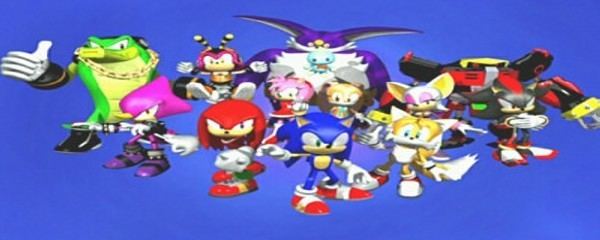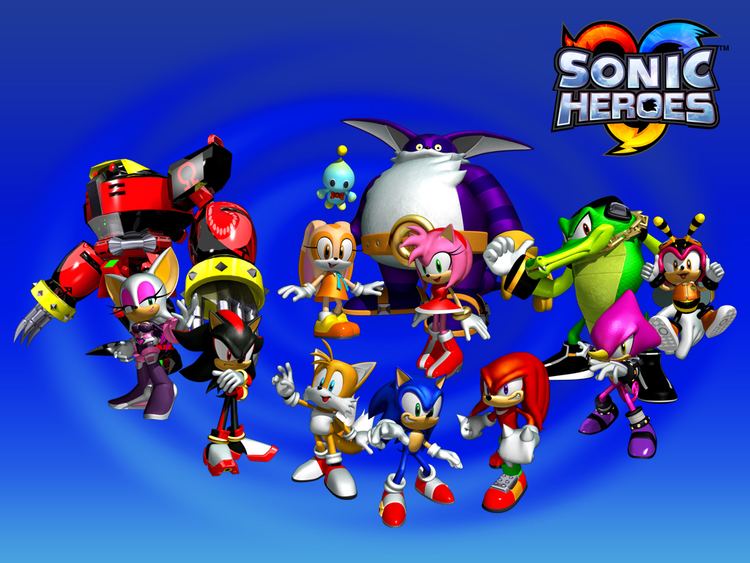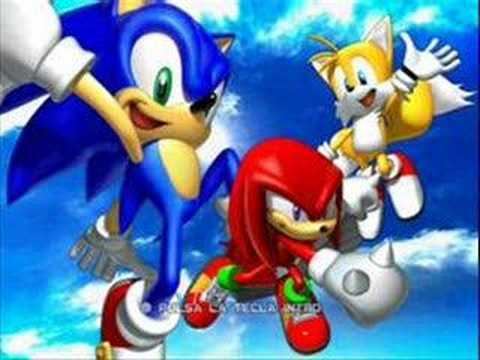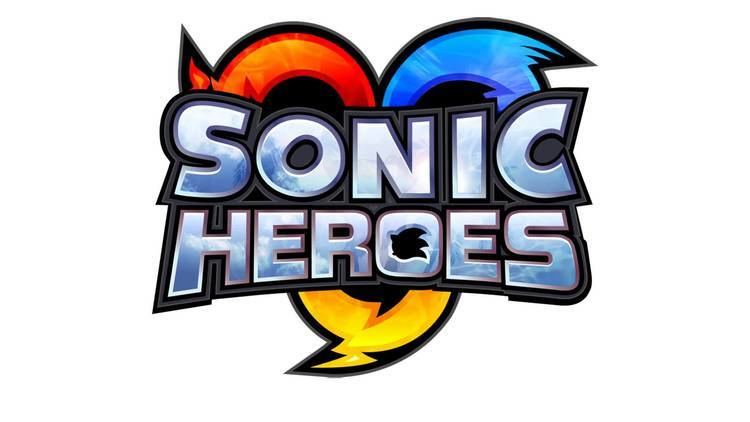8.2 /10 1 Votes8.2
4.5/5 PlayStation®Store Writer(s) Shiro Maekawa Initial release date 5 December 2003 Developers Sega, Sonic Team | 64% GameFAQs 4.5/5 Emuparadise Genre Platform game | |||||||||||||||||||||||||||||||||
 | ||||||||||||||||||||||||||||||||||
Similar Sonic the Hedgehog games, Sega games, Racing video games | ||||||||||||||||||||||||||||||||||
Sonic heroes playthrough part 1
Sonic Heroes (ソニック ヒーローズ, Sonikku Hīrōzu) is a platform video game in the Sonic the Hedgehog series, developed by Sonic Team USA and published by Sega for the GameCube, PlayStation 2, Xbox consoles and Microsoft Windows. It was first released in Japan in December 2003, and then worldwide in early 2004. Released approximately two years after the series' prior entry, Sonic Adventure 2, it is notable for being the first entry to released on Sony and Microsoft consoles. Sonic Heroes surrounds Sonic, who teams with his friends Tails and Knuckles to stop series antagonist Doctor Eggman, who claims to have a weapon to help him take over the world in three days, while Amy Rose collaborates with her friends to find Sonic and Rouge forms an alliance with Shadow and E-123 Omega to find Eggman. Contrary to other entries in the series, Sonic Heroes features twelve playable characters, all of which playable in pre-determined teams of three. Gameplay surrounds switching between different characters and taking advantage of each's unique abilities to complete levels.
Contents
- Sonic heroes playthrough part 1
- Sonic heroes ps2 part 01 opening team sonic seaside hill bonus 1
- Gameplay
- Plot
- Development and release
- Reception
- Legacy
- References

Sonic Heroes was met with mixed to positive reviews upon release. Critics generally praised the game's graphics and soundtrack, but criticized the game's camera system and voice acting; reviewers were more divided on the multiplayer concept. The game ultimately sold well commercially, becoming a million-seller and making the best-seller's list for all three of its original platforms. A stand-alone sequel, Sonic Unleashed, was released in 2008.

Sonic heroes ps2 part 01 opening team sonic seaside hill bonus 1
Gameplay

Sonic Heroes is a platform game in which players navigate through numerous levels using teams of three characters. The game features four teams; Team Sonic, Team Dark, Team Rose, and Team Chaotix, each with their own campaigns. Team Rose, Team Sonic, and Team Dark represent easy, medium, and hard difficulties respectively, with the harder difficulties featuring longer stages and tougher enemies. Team Chaotix's levels, on the other hand, are mission based, requiring players to fulfill a specific objective in order to clear each level. Each team contains three character types; Speed, Power, and Flight, which the player toggles between at any time, also changing the team's running formation. Speed characters can perform homing attacks and light dashes, and can form whirlwinds to climb up poles, Power characters can break through objects and glide on air fans, and Flight characters can temporarily fly in the air and attack airborne enemies. By acquiring certain items or enemies, characters can level up, becoming more efficient when fighting against enemies.

Like previous games, players collect rings to protect themselves and earn extra lives, which are lost if players are attacked with no rings, fall into pits, or fail certain objectives. By defeating enemies and collecting rings, players can build up a Team Blast meter, which can be used to perform a powerful attack that destroys all on-screen opponents, as well as activate certain abilities unique to each team. By collecting a key hidden within each level and reaching the end of the level without getting hit, players can enter the Special Stage, in which players speed across a tube, collecting spheres containing boost power whilst avoiding obstacles. If the stage is entered via Act 2 of each zone, an Emerald Challenge takes place in which players must catch a Chaos Emerald before it reaches the end of the stage. If players can collect all seven emeralds and clear each team's story, an additional Last Story is unlocked. The game also features a multiplayer mode, in which two players can race or battle against each other.
Plot
Sonic and his friends, Tails and Knuckles, receive a letter of challenge from Eggman, who claims to have an ultimate weapon that he will use to take over the world in 3 days. As the team sets off to put a stop to Eggman's plans, Amy Rose, who is infatuated with Sonic, teams up with Cream and Big to help them search for their missing friends, Chocola and Froggy, who were supposedly seen being kidnapped by Sonic. Elsewhere, Rouge the Bat infiltrates one of Eggman's bases, where she discovers Shadow, who was presumed dead following the battle aboard Colony ARK, and a discarded robot named E-123 Omega. With Shadow missing his memories and Omega seeking revenge against Eggman for sealing him away, Rouge, who wants to get ahold of Eggman's treasure, forms a team with them. Meanwhile, the Chaotix Detective Agency, formed of Vector the Crocodile, Espio the Chameleon, and Charmy Bee, receive a job from a mysterious client who communicates with them via walkie-talkie, which they blindy accept due to needing the money.
As the teams make their way towards Eggman's whereabouts, clashing with each other along the way, many of the characters start having doubts about the identity of their true adversary. Unbeknownst to them, someone is hiding behind the scenes, posing as Eggman and secretly obtaining data from his enemies. After Eggman's final machine is defeated, Team Rose is reunited with Chocola and Froggy, while Team Chaotix discover that their mysterious client is actually the real Eggman, who had been locked away by his impostor, revealed to be Metal Sonic. Using the data he had copied from his enemies, Metal Sonic transforms himself into the Metal Overlord in order to prove himself as the ultimate being. However, Sonic uses the power of the Chaos Emeralds to transform into Super Sonic and, with help from his teammates, defeats Metal Overlord, who reverts back to normal. As the heroes disperse, Sonic and his team run off in anticipation of their next adventure.
Development and release
The video game was developed to celebrate Sonic's 12th anniversary. The game's director, Takashi Iizuka, stated that he did not want to make Sonic Heroes a continuation of the Sonic Adventure series, as he was worried only core gamers would buy the title, and instead decided to create a game that more casual players could adapt to.
Sonic Heroes uses the RenderWare engine so that the game could be programmed and ported easily to the GameCube, PlayStation 2, Xbox, and Microsoft Windows. Despite being able to port some textures and character models from the Sonic Adventure titles, most work on the title was done from scratch. Sonic Heroes was Sega's first multi-platform title, and the development team found additional challenges in working with the Xbox, a platform with which they had very little experience.
The video game was later released in a package with Super Monkey Ball Deluxe on Xbox, then in 2009 as a part of Sonic PC Collection, and finally in 2012 for PlayStation Network. As part of the PlayStation 2 classics program, the PlayStation 2 version was re-released in Europe on the PlayStation Network in late February 2012 and September 17, 2014 in Japan.
Jun Senoue composed the majority of the music and theme songs for Sonic Heroes. Letters to Cleo lead singer Kay Hanley provided vocals for the song "Follow Me". The electronic rock band Julien-K contributed the song "This Machine" to the soundtrack as well. Iizuka has said that the intention was for the music to return to the roots of the Sonic experience and to be exciting and fast-paced.
The Sonic Heroes Official Soundtrack was released in North America on November 9, 2004. Triple Threat: Sonic Heroes Vocal Trax, which also includes the vocal theme songs from Sonic Adventure, was released in Japan on February 4, 2004. Complete Trinity: Sonic Heroes - Original Soundtrax was released in Japan on March 3, 2004. To commemorate the series' 20th anniversary, the game's official soundtrack was re-released on August 24, 2011 in Japan as Sonic Heroes Original Soundtrack 20th Anniversary Edition.
Reception
Reviews of the video game were generally mixed, with Metacritic ranging from 64% for the PlayStation 2 version, based on 29 reviews, to 73% for the Xbox version, based on 28 reviews. GameRankings averages range from 60% for the PC version, based on 9 reviews, to 75% for the GameCube version, based on 35 reviews.
GameSpot noted that the gameplay of Sonic Heroes came close to the series' 2D roots and praised the sound design, describing it as "inexorably linked" to the experience. IGN called the sound "at least very pristine" with "perfectly implemented" sound effects, running in Dolby Pro Logic II. Graphics design and environments were also highlighted, described as colorful, vibrant and cheery, with consistent art design and an exceptionally vibrant color palette. Framerate was also consistent for the Xbox, GameCube, and PC versions, although a drop in framerate in the multiplayer component was noted.
The video game's camera control system was an often-cited criticism, described as "uncooperative" and "terrible". Coordination between camera position and character movement also caused problems, such that pushing forward may not move the character in the same direction the camera is facing. The game's voice acting was also criticized, being described as "horrendous" and "the biggest misstep in the sound design".
The PlayStation 2 version received lower average scores. It suffered from clipping, graphic faults, and a lower framerate than the other versions.
In 2004, Sonic Heroes was the sixth bestselling game in the United Kingdom overall and was still at number eight in the all-price chart a year after its release. By October 2004, the game had sold over one million copies in Europe. The game ultimately sold well enough to enter all three consoles' "best-sellers" lists: Greatest Hits/Platinum for the PlayStation 2, Platinum Hits/Classics for the Xbox, and Player's Choice for the GameCube.
Legacy
For Sonic's 20th Anniversary, Sega released Sonic Generations, a game that remade aspects of various past games from the franchise. The PlayStation 3, Xbox 360 and PC version contained a remade "Seaside Hill" level. The Nintendo 3DS version contained a remake of the "Egg Emperor" boss fight. Additionally, Sonic & Sega All-Stars Racing contained race tracks that are based on locations from Sonic Heroes, including the Seaside Hill, Casino Park, and Final Fortress levels. The sequel, Sonic & All-Stars Racing Transformed, featured a new racetrack that takes place in Seaside Hill, and featured one of the Casino Park racetracks that had appeared in its predecessor. Seaside Hill was also adapted as the setting for the mobile game Sonic Dash.
